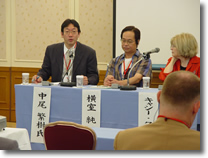| |
|
| |
Dates:
|
Sunday
10th July 2005, 13:00-16:00 |
Venue:
|
Portopia
Hotel, eBanquet Room NUNOBIKI,KITANOf (Main Building B1F)
10-1, 6 Chome, Minatojima Nakamachi, Chuo-ku, Kobe, Japan
URL:http://www.portopia.co.jp/
|
Organizer:
|
NPO Knots
|
Purpose:
|
By focusing
on and considering the deep relationships that children can have
with dogs, while in their developing years, the symposium hopes
to further contribute to our knowledge on positive child development.
Also, the symposium hopes to demonstrate the best forms of co-existence
between people and animals, and to nurture an animal-loving consciousness
and promote the importance of correct techniques for looking after
animals, as well as to contribute to realizing a society of harmonious
human-animal co-existence.
|
Participating
Organization :
|
|
|
The Great
Earthquake Animal Rescue Memorial Association
(consisting of Hyogo prefecture, Kobe City, Veterinary Association of Hyogo
prefecture, Veterinary Association Kobe City, Japan Animal Welfare Society
Hanshin Branch)
|
Special
Sponsor:
|
Nestle
Purina PetCare
|
Sponsor:
|
Asahi
Breweries, Ltd.,
|
Helping
Organizations:
|
|
|
Hanshin
Earthquake 10th Anniversary Commemorative Project Promotion Conference
/ "Messages from Kobe: Tenth Anniversary of the Great Hanshin-Awaji
Earthquake" Promotion Committee. / Tsutomu Nakauchi Foundation
|
Supporting
Organizations:
|
|
|
Hyogo Prefecture / Kobe City / Hyogo Prefecture
Board of Education / Kobe City Board of Education / Japan Veterinary
Medical Association / Veterinary Association of Hyogo Prefecture
/ Veterinary Association of Kobe City / Japan Society for the
Prevention of Cruelty@to Animals, JSPCA / JAPANESE SOCIETY
OF HUMANE CARE OF ANIMALS / Japan Animal Welfare Society /
Japan Pet Care Association / Japanese Animal Hospital Association
(JAHA) / Osaka Kobe Consulate General of the USA, Kansai American
Center
|
Chairperson:
|
Ms.
Keiko YAMAZAKI, Companion Animal Study Group gGoh
|
Speaker:
|
Case Study Introductions (45 minutes each)
Dr.
Kathy Klotz, Executive Director Intermountain Therapy
Animals (USA)@
eR.E.A.D.(Reading Education Assistance Dogs) Programf
Mr.
Junichi YOKOMURO, @Trainer of development disabled children
eTreatment of Development Disabled Children using
Therapy Dogsf
Explanation of Development Psychology and Comments
on Animal Roles (based on each case study).
Mr.
Shigeki NAKAO,@Supervisor of Special Support Education Division@Kobe
City Board of Education
@@@@@@@
Panel Discussion with Questions and Answers
Panelists
@E
Dr. Kathy Klotz
@E
Mr. Junichi YOKOMURO
@E
Mr. Shigeki NAKAO
|
|
| |
|
As this yearfs symposium coincided
with the 10th anniversary of the great earthquake, we received a message
from the Mayor of Kobe City. |
|
|
gI would like to offer my congratulations to the 2005
Live Love Animals International Symposium.
I am also most grateful that you are participating within the Earthquake 10th
Anniversary Commemorative Project and are actively keeping Kobe in communication
with the world.
Kobe experienced the importance of animal and human co-existence after the
earthquake.
Therefore, through this project, I hope that Kobe can promote the spirit of
a deeper appreciation for animals far and wide. I hope also that this will
lead to the creation of a more advanced society in which people and animals
share their lives in harmony.
May I also send my sincere wishes for good health and prosperity to all the
symposium participants.
Mayor of Kobe City,
Tatsuo YADA |
|
|
|
The Executive Director of eIntermountain
Therapy Animals Inc.f, Ms. Kathy Klotz, was guest speaker at the symposium
and she presented some
interesting case studies. Intermountain Therapy Animals Inc. developed
and operates a unique system for improving reading abilities in children
by a method in which children read to dogs. The system is called the
R.E.A.D. Program and was developed alongside the creation of eReading
Education Assistance Dogsf.
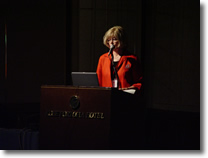 In
her lecture, Ms. Klotz remarked on the importance of preparing a relaxed
atmosphere in which children can get on with their learning
without any stress. The R.E.A.D. dogs are ideal partners for children
when they read because, even if a child makes a mistake, the dog does
not criticize, tease or laugh. Instead they patiently and attentively
listen, meaning that children pursue their reading with confidence
and assurance. In
her lecture, Ms. Klotz remarked on the importance of preparing a relaxed
atmosphere in which children can get on with their learning
without any stress. The R.E.A.D. dogs are ideal partners for children
when they read because, even if a child makes a mistake, the dog does
not criticize, tease or laugh. Instead they patiently and attentively
listen, meaning that children pursue their reading with confidence
and assurance.
During her talk, the audience could immediately sense the great improvements
made by the children as well as the other positive benefits beyond an increased
reading ability. These effects are achievable, based on a strong supportive structure
that comprises the R.E.A.D. dogs, program staff and the educational and medical
specialists. Ms. Klotz also showed the activities of R.E.A.D. dogs in youth detention
facilities and hospitals. R.E.A.D. is still not well known in Japan so the audience
showed a great interest.
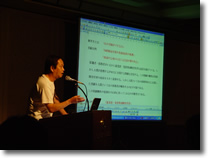 Next,
Mr. Junichiro YOKOMURO, President of the BAT Rehabilitation Project for
Children with Development Diseases, and Representative
of the Japan Association of Therapy Dogs for Children with Mental Disabilities
spoke about the effects of therapy dogs on children with developmental
problems. Such children, on the whole, tend to exhibit behavioral restrictions,
often being passive, apathetic or waiting to be told what to do. The
role of therapy dogs is to induce spontaneous behavior that cannot
be taught by other people. The influence dogs have on the psychology
of handicapped children was also stressed. Mr. Yokomuro explained,
through the use of case studies, how the therapy dogs working on the
handicapped childfs mind can have very apparent effects due an environment
where children and therapy dogs can freely express their thoughts,
wishes and actions. Mr. Yokomuro also stated his views about guide
dogs and assistance dogs as used currently in Japan, inviting us all
to consider how such dogs should be used from now on in this country.
As his comments were based on real case situations, Mr. Yokomurofs
talk was very convincing and powerful. Next,
Mr. Junichiro YOKOMURO, President of the BAT Rehabilitation Project for
Children with Development Diseases, and Representative
of the Japan Association of Therapy Dogs for Children with Mental Disabilities
spoke about the effects of therapy dogs on children with developmental
problems. Such children, on the whole, tend to exhibit behavioral restrictions,
often being passive, apathetic or waiting to be told what to do. The
role of therapy dogs is to induce spontaneous behavior that cannot
be taught by other people. The influence dogs have on the psychology
of handicapped children was also stressed. Mr. Yokomuro explained,
through the use of case studies, how the therapy dogs working on the
handicapped childfs mind can have very apparent effects due an environment
where children and therapy dogs can freely express their thoughts,
wishes and actions. Mr. Yokomuro also stated his views about guide
dogs and assistance dogs as used currently in Japan, inviting us all
to consider how such dogs should be used from now on in this country.
As his comments were based on real case situations, Mr. Yokomurofs
talk was very convincing and powerful.
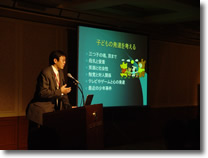 The
third panelist was Mr. Shigeki NAKAO, Supervisor of the Special Support
Education Division of Kobe Cityfs Board of Education. Mr. Nakao
talked about the psychological development of children and the role
of animals. He stated that the esense of touchf is extremely important
when considering the mental development of children and this has an
influence on their relationship with parents, with other people and
their powers of communication. Furthermore, when animals are around,
their emotional state can be stabilized. The relaxed state allows them
to exhibit their reactions better. Mr. Nakao also explained that, for
children, especially emotionally unstable children, animals can provide
a sense of security in which they feel eunconditionally acceptedf.
The behavior that parents need to show towards their children was also
explained. He had the audience laughing heartily with his comment that,
ewhat I also learned from Ms. Klotzfs lecture is that the therapy qualifications
the dogs have achieved are just like the ones the educationalists trained
forf. On a more serious note, he explained that the volume of information
children nowadays receive is incomparably greater than in older times
and that their physical development is not keeping in balance with
this information avalanche. The imbalance of the mental and physical
development is the cause of some big problems that modern children
have. This made us think.@ The
third panelist was Mr. Shigeki NAKAO, Supervisor of the Special Support
Education Division of Kobe Cityfs Board of Education. Mr. Nakao
talked about the psychological development of children and the role
of animals. He stated that the esense of touchf is extremely important
when considering the mental development of children and this has an
influence on their relationship with parents, with other people and
their powers of communication. Furthermore, when animals are around,
their emotional state can be stabilized. The relaxed state allows them
to exhibit their reactions better. Mr. Nakao also explained that, for
children, especially emotionally unstable children, animals can provide
a sense of security in which they feel eunconditionally acceptedf.
The behavior that parents need to show towards their children was also
explained. He had the audience laughing heartily with his comment that,
ewhat I also learned from Ms. Klotzfs lecture is that the therapy qualifications
the dogs have achieved are just like the ones the educationalists trained
forf. On a more serious note, he explained that the volume of information
children nowadays receive is incomparably greater than in older times
and that their physical development is not keeping in balance with
this information avalanche. The imbalance of the mental and physical
development is the cause of some big problems that modern children
have. This made us think.@
@@@
|
 This
event was the third Live Love Animals International Symposium for pet
researcher Ms. Keiko YAMAZAKI who served as Chairperson. Thanks
to her, the symposium proceeded smoothly despite running over time.
For the Question and Answers time during the panel discussion, the
three panelists openly answered questions from the floor. As on previous
occasions, the venue was full and many people had traveled from far
away to attend the symposium, something that indicates the great interest
this event clearly generates. The running time was extended well beyond
the end time but all attending listened with great interest until the
close. This symposium gave us the opportunity to consider the issues
important to the psychological development of children and confirmed
the value, and indeed the special nature, of communication between
children and animals. It was also made clear that the importance of
the relationship between children and animals is in need of even more
serious consideration. This
event was the third Live Love Animals International Symposium for pet
researcher Ms. Keiko YAMAZAKI who served as Chairperson. Thanks
to her, the symposium proceeded smoothly despite running over time.
For the Question and Answers time during the panel discussion, the
three panelists openly answered questions from the floor. As on previous
occasions, the venue was full and many people had traveled from far
away to attend the symposium, something that indicates the great interest
this event clearly generates. The running time was extended well beyond
the end time but all attending listened with great interest until the
close. This symposium gave us the opportunity to consider the issues
important to the psychological development of children and confirmed
the value, and indeed the special nature, of communication between
children and animals. It was also made clear that the importance of
the relationship between children and animals is in need of even more
serious consideration.
|
|
| |
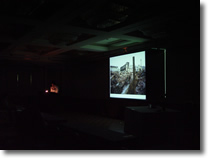 The
symposium was held as one of the commemorative projects for the 10th
anniversary of Hanshin-Awaji Great Earthquake. Therefore, at the
very end of the program, a slide-show entitled eLooking back at the
activities of the Hanshin-Awaji Great Earthquake: the rescue of 1556
animal livesf was screened. Both people and animals faced a number
of huge difficulties following the earthquake. However, people helped
one another to overcome them. The photographs showed how people worked
very hard to rescue animals too. Several members of the audience were
obviously reminded of difficult times and memories, and the sound of
sobbing was discernible. The
symposium was held as one of the commemorative projects for the 10th
anniversary of Hanshin-Awaji Great Earthquake. Therefore, at the
very end of the program, a slide-show entitled eLooking back at the
activities of the Hanshin-Awaji Great Earthquake: the rescue of 1556
animal livesf was screened. Both people and animals faced a number
of huge difficulties following the earthquake. However, people helped
one another to overcome them. The photographs showed how people worked
very hard to rescue animals too. Several members of the audience were
obviously reminded of difficult times and memories, and the sound of
sobbing was discernible.
@ |
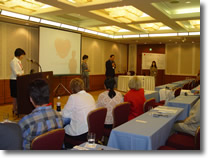 After
the slide show, the eLive Love Animals Special Awardf was presented to
Dr. Masahiko HATAYA (then Chairman of Kobe City Veterinary Association)
and Ms. Sanae MATSUDA (Vice Branch Manager of the Japan Animal Welfare
Society Hanshin Branch at the time of the disaster). It was these people
who initiated and acted at the core of the animal rescue effort immediately
after the quake. Dr. Hataya had been home doctor to Ms. Matsudafs pets
and their mutual trust proved to be the solid foundation on which their
great work was built. The award was presented to convey a special message
for the 10th anniversary, a message that ethe combination of deep trust
and strong willpower can change the societyf. The presentation had
been kept a secret so it was a great surprise to the recipients. After
the slide show, the eLive Love Animals Special Awardf was presented to
Dr. Masahiko HATAYA (then Chairman of Kobe City Veterinary Association)
and Ms. Sanae MATSUDA (Vice Branch Manager of the Japan Animal Welfare
Society Hanshin Branch at the time of the disaster). It was these people
who initiated and acted at the core of the animal rescue effort immediately
after the quake. Dr. Hataya had been home doctor to Ms. Matsudafs pets
and their mutual trust proved to be the solid foundation on which their
great work was built. The award was presented to convey a special message
for the 10th anniversary, a message that ethe combination of deep trust
and strong willpower can change the societyf. The presentation had
been kept a secret so it was a great surprise to the recipients.
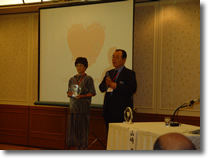 Dr.
Hataya said that he hopes the younger generation will learn from such meetings
and be inspired towards new initiatives. Ms. Matsuda stressed that there are
many more issues yet to be improved and that individuals have the power to make
the changes needed. Dr.
Hataya said that he hopes the younger generation will learn from such meetings
and be inspired towards new initiatives. Ms. Matsuda stressed that there are
many more issues yet to be improved and that individuals have the power to make
the changes needed.
If the post-quake rescue project had not happened, Knots itself may probably
have not been founded. Knots will never forget the reason for its creation and
is committed to continue the work it has started.
Located next to the symposium registration desk there was also a panel exhibition
showing and explaining the animal rescue efforts after the earthquake. |
| This display
was thanks to the cooperation of the Great Earthquake Animal Rescue Memorial
Association. Many people studied the panels with interest. |
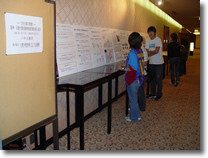 |
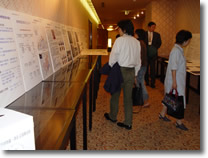 |
| Panel Exhibition |
eLooking back
at the activities of the Hanshin-Awaji Great Earthquake: the
rescue of 1556 animal livesf |
|
| |
| |
|
| |
 @@@@@  @@ |
| |
| |
| |

 This
event was the third Live Love Animals International Symposium for pet
researcher Ms. Keiko YAMAZAKI who served as Chairperson. Thanks
to her, the symposium proceeded smoothly despite running over time.
For the Question and Answers time during the panel discussion, the
three panelists openly answered questions from the floor. As on previous
occasions, the venue was full and many people had traveled from far
away to attend the symposium, something that indicates the great interest
this event clearly generates. The running time was extended well beyond
the end time but all attending listened with great interest until the
close. This symposium gave us the opportunity to consider the issues
important to the psychological development of children and confirmed
the value, and indeed the special nature, of communication between
children and animals. It was also made clear that the importance of
the relationship between children and animals is in need of even more
serious consideration.
This
event was the third Live Love Animals International Symposium for pet
researcher Ms. Keiko YAMAZAKI who served as Chairperson. Thanks
to her, the symposium proceeded smoothly despite running over time.
For the Question and Answers time during the panel discussion, the
three panelists openly answered questions from the floor. As on previous
occasions, the venue was full and many people had traveled from far
away to attend the symposium, something that indicates the great interest
this event clearly generates. The running time was extended well beyond
the end time but all attending listened with great interest until the
close. This symposium gave us the opportunity to consider the issues
important to the psychological development of children and confirmed
the value, and indeed the special nature, of communication between
children and animals. It was also made clear that the importance of
the relationship between children and animals is in need of even more
serious consideration. The
symposium was held as one of the commemorative projects for the 10th
anniversary of Hanshin-Awaji Great Earthquake. Therefore, at the
very end of the program, a slide-show entitled eLooking back at the
activities of the Hanshin-Awaji Great Earthquake: the rescue of 1556
animal livesf was screened. Both people and animals faced a number
of huge difficulties following the earthquake. However, people helped
one another to overcome them. The photographs showed how people worked
very hard to rescue animals too. Several members of the audience were
obviously reminded of difficult times and memories, and the sound of
sobbing was discernible.
The
symposium was held as one of the commemorative projects for the 10th
anniversary of Hanshin-Awaji Great Earthquake. Therefore, at the
very end of the program, a slide-show entitled eLooking back at the
activities of the Hanshin-Awaji Great Earthquake: the rescue of 1556
animal livesf was screened. Both people and animals faced a number
of huge difficulties following the earthquake. However, people helped
one another to overcome them. The photographs showed how people worked
very hard to rescue animals too. Several members of the audience were
obviously reminded of difficult times and memories, and the sound of
sobbing was discernible. After
the slide show, the eLive Love Animals Special Awardf was presented to
Dr. Masahiko HATAYA (then Chairman of Kobe City Veterinary Association)
and Ms. Sanae MATSUDA (Vice Branch Manager of the Japan Animal Welfare
Society Hanshin Branch at the time of the disaster). It was these people
who initiated and acted at the core of the animal rescue effort immediately
after the quake. Dr. Hataya had been home doctor to Ms. Matsudafs pets
and their mutual trust proved to be the solid foundation on which their
great work was built. The award was presented to convey a special message
for the 10th anniversary, a message that ethe combination of deep trust
and strong willpower can change the societyf. The presentation had
been kept a secret so it was a great surprise to the recipients.
After
the slide show, the eLive Love Animals Special Awardf was presented to
Dr. Masahiko HATAYA (then Chairman of Kobe City Veterinary Association)
and Ms. Sanae MATSUDA (Vice Branch Manager of the Japan Animal Welfare
Society Hanshin Branch at the time of the disaster). It was these people
who initiated and acted at the core of the animal rescue effort immediately
after the quake. Dr. Hataya had been home doctor to Ms. Matsudafs pets
and their mutual trust proved to be the solid foundation on which their
great work was built. The award was presented to convey a special message
for the 10th anniversary, a message that ethe combination of deep trust
and strong willpower can change the societyf. The presentation had
been kept a secret so it was a great surprise to the recipients.  Dr.
Hataya said that he hopes the younger generation will learn from such meetings
and be inspired towards new initiatives. Ms. Matsuda stressed that there are
many more issues yet to be improved and that individuals have the power to make
the changes needed.
Dr.
Hataya said that he hopes the younger generation will learn from such meetings
and be inspired towards new initiatives. Ms. Matsuda stressed that there are
many more issues yet to be improved and that individuals have the power to make
the changes needed.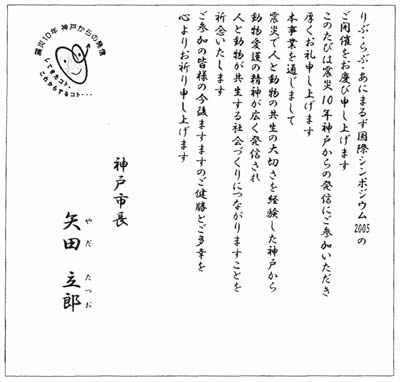
 In
her lecture, Ms. Klotz remarked on the importance of preparing a relaxed
atmosphere in which children can get on with their learning
without any stress. The R.E.A.D. dogs are ideal partners for children
when they read because, even if a child makes a mistake, the dog does
not criticize, tease or laugh. Instead they patiently and attentively
listen, meaning that children pursue their reading with confidence
and assurance.
In
her lecture, Ms. Klotz remarked on the importance of preparing a relaxed
atmosphere in which children can get on with their learning
without any stress. The R.E.A.D. dogs are ideal partners for children
when they read because, even if a child makes a mistake, the dog does
not criticize, tease or laugh. Instead they patiently and attentively
listen, meaning that children pursue their reading with confidence
and assurance.  Next,
Mr. Junichiro YOKOMURO, President of the BAT Rehabilitation Project for
Children with Development Diseases, and Representative
of the Japan Association of Therapy Dogs for Children with Mental Disabilities
spoke about the effects of therapy dogs on children with developmental
problems. Such children, on the whole, tend to exhibit behavioral restrictions,
often being passive, apathetic or waiting to be told what to do. The
role of therapy dogs is to induce spontaneous behavior that cannot
be taught by other people. The influence dogs have on the psychology
of handicapped children was also stressed. Mr. Yokomuro explained,
through the use of case studies, how the therapy dogs working on the
handicapped childfs mind can have very apparent effects due an environment
where children and therapy dogs can freely express their thoughts,
wishes and actions. Mr. Yokomuro also stated his views about guide
dogs and assistance dogs as used currently in Japan, inviting us all
to consider how such dogs should be used from now on in this country.
As his comments were based on real case situations, Mr. Yokomurofs
talk was very convincing and powerful.
Next,
Mr. Junichiro YOKOMURO, President of the BAT Rehabilitation Project for
Children with Development Diseases, and Representative
of the Japan Association of Therapy Dogs for Children with Mental Disabilities
spoke about the effects of therapy dogs on children with developmental
problems. Such children, on the whole, tend to exhibit behavioral restrictions,
often being passive, apathetic or waiting to be told what to do. The
role of therapy dogs is to induce spontaneous behavior that cannot
be taught by other people. The influence dogs have on the psychology
of handicapped children was also stressed. Mr. Yokomuro explained,
through the use of case studies, how the therapy dogs working on the
handicapped childfs mind can have very apparent effects due an environment
where children and therapy dogs can freely express their thoughts,
wishes and actions. Mr. Yokomuro also stated his views about guide
dogs and assistance dogs as used currently in Japan, inviting us all
to consider how such dogs should be used from now on in this country.
As his comments were based on real case situations, Mr. Yokomurofs
talk was very convincing and powerful. The
third panelist was Mr. Shigeki NAKAO, Supervisor of the Special Support
Education Division of Kobe Cityfs Board of Education. Mr. Nakao
talked about the psychological development of children and the role
of animals. He stated that the esense of touchf is extremely important
when considering the mental development of children and this has an
influence on their relationship with parents, with other people and
their powers of communication. Furthermore, when animals are around,
their emotional state can be stabilized. The relaxed state allows them
to exhibit their reactions better. Mr. Nakao also explained that, for
children, especially emotionally unstable children, animals can provide
a sense of security in which they feel eunconditionally acceptedf.
The behavior that parents need to show towards their children was also
explained. He had the audience laughing heartily with his comment that,
ewhat I also learned from Ms. Klotzfs lecture is that the therapy qualifications
the dogs have achieved are just like the ones the educationalists trained
forf. On a more serious note, he explained that the volume of information
children nowadays receive is incomparably greater than in older times
and that their physical development is not keeping in balance with
this information avalanche. The imbalance of the mental and physical
development is the cause of some big problems that modern children
have. This made us think.
The
third panelist was Mr. Shigeki NAKAO, Supervisor of the Special Support
Education Division of Kobe Cityfs Board of Education. Mr. Nakao
talked about the psychological development of children and the role
of animals. He stated that the esense of touchf is extremely important
when considering the mental development of children and this has an
influence on their relationship with parents, with other people and
their powers of communication. Furthermore, when animals are around,
their emotional state can be stabilized. The relaxed state allows them
to exhibit their reactions better. Mr. Nakao also explained that, for
children, especially emotionally unstable children, animals can provide
a sense of security in which they feel eunconditionally acceptedf.
The behavior that parents need to show towards their children was also
explained. He had the audience laughing heartily with his comment that,
ewhat I also learned from Ms. Klotzfs lecture is that the therapy qualifications
the dogs have achieved are just like the ones the educationalists trained
forf. On a more serious note, he explained that the volume of information
children nowadays receive is incomparably greater than in older times
and that their physical development is not keeping in balance with
this information avalanche. The imbalance of the mental and physical
development is the cause of some big problems that modern children
have. This made us think.